We may not have the course you’re looking for. If you enquire or give us a call on 01344203999 and speak to our training experts, we may still be able to help with your training requirements.
Training Outcomes Within Your Budget!
We ensure quality, budget-alignment, and timely delivery by our expert instructors.
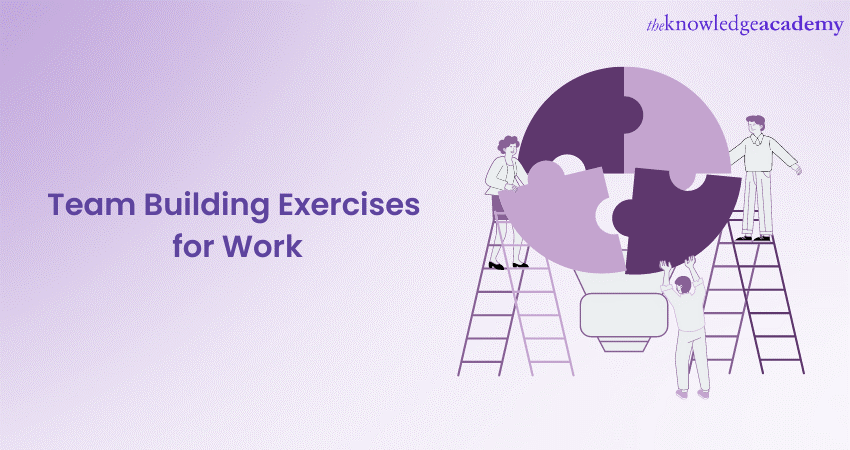
With the pandemic hitting the world, everybody was restricted to work from their homes. They learnt to work in a team on virtual platforms. However, to make the employees feel connected and regain the old comraderies between members, many organisations practised Team Building Exercises, which are still prevalent after the pandemic.
The reason for carrying out Team Building Exercises for work is to increase effective communication. According to TeamStage, effective communication generates 4.5 times higher retention of talent. These statistics clearly reflect that Team Building is more important than ever.
In this blog, we will learn about various types of Team Building Exercises, how they help create thriving and harmonious teams and encourage cooperation and bonding.
Table of Contents
1) Why are Team Building Exercises necessary?
2) What are the types of Team Building Exercises?
a) Ice breaker exercises
b) Communication exercises
c) Problem solving exercises
d) Trust building exercises
e) Fun and engaging exercises
3) Conclusion
Why are Team Building Exercises necessary?
Team Building Exercises are not just recreational activities; they are a pivotal part of a company's strategy to build a strong, interconnected workforce. They foster open communication, promoting understanding and eradicating any misconceptions or biases that could harm the team's performance.
By creating an environment that encourages collaboration, these exercises enable team members to pool their individual skills for the collective success of the organisation. Moreover, Team Building Exercises for work enhance problem-solving abilities. They also instil a sense of trust and mutual respect among team members.

What are the types of Team Building Exercises?
Team Building Exercises are of various types. Each of these is designed to address specific areas of team dynamics. They can be categorised into ice breaker, communication, problem-solving, trust-building, and fun and engaging exercises. Let us look at some fun Team Building Exercises:
a) Ice breaker exercises
There are some ice-breaker exercises that you can follow or you can ask your organisation to follow to have a stronger team bonding:
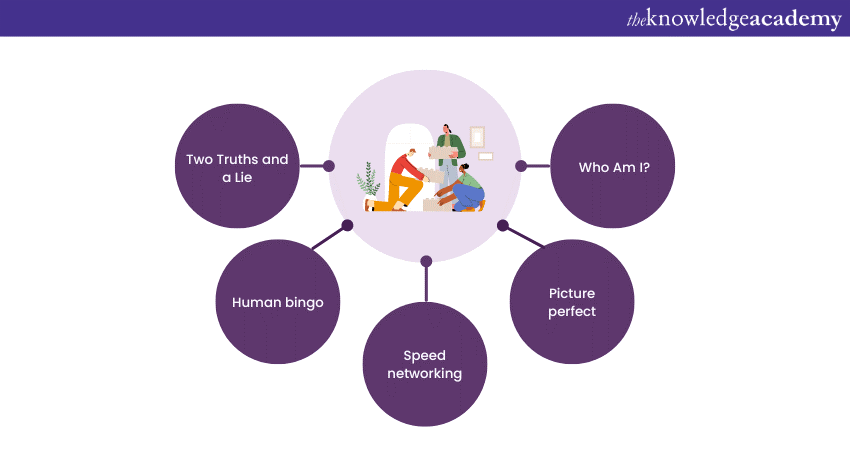
1) Two truths and a lie: In this exercise, each participant presents three statements about themselves, two of which are true, and one is a lie. The rest of the team members then guess which statement is false. This game is a perfect way for team members to learn some interesting facts about each other. It fosters a sense of familiarity and camaraderie.
2) Human bingo: In Human bingo, each participant receives a bingo card filled with unique characteristics, hobbies, or experiences instead of numbers. Participants have to mingle and find team members who match the attributes on their cards. This involves encouraging interaction and better understanding each other's backgrounds and personalities.
3) Speed networking: This exercise is especially useful for large teams or organisations. Participants have a short, predetermined amount of time to introduce themselves and share something interesting before moving to the next person. This allows team members to interact with individuals they might not regularly work with. As a result, it broadens their internal network.
4) Picture perfect: This activity involves participants describing a picture to their team members. These members then recreate the image based solely on the description. It's a fantastic way to highlight the importance of clear communication and bring out the creative side of team members.
5) Who am I?: In this game, each participant sticks a post-it note with the name of a famous person on their forehead. They then ask yes/no questions to guess their identity. It's a fun way to start a meeting and gets people into a problem-solving mindset.
b) Communication exercises
Team Building Exercises also include communication exercises. They are designed to improve and strengthen open dialogue among team members. These kinds of Team Building Activities help enhance Active Listening Skills, verbal and non-verbal communication. This also increases the ability to articulate ideas effectively, which in turn fosters better team understanding and minimises misunderstandings. Here are some examples:
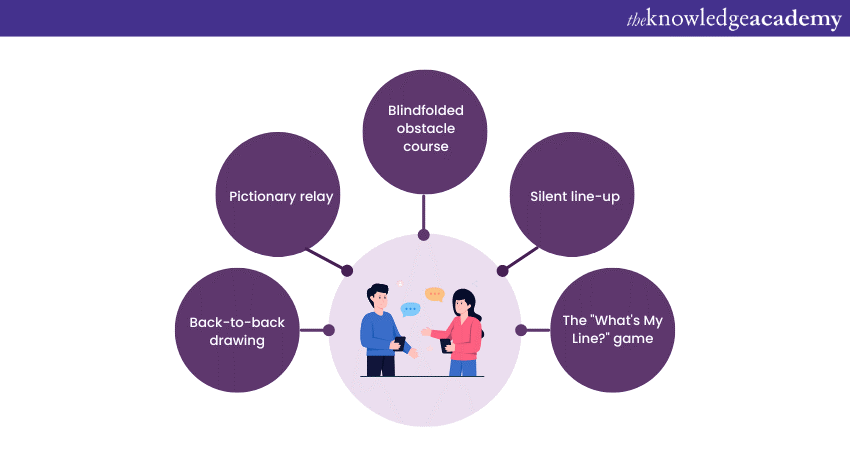
1) Back-to-back drawing: In this exercise, pairs sit back-to-back. One person is given a picture which they describe to the other person, who attempts to draw it based on the description. This activity underscores the importance of clear and detailed communication.
2) Pictionary relay: This type of Team Building activity requires one team member to draw a given word while the others guess what the word is. This emphasises the role of non-verbal communication and shows how different interpretations can lead to confusion if not clarified.
3) Blindfolded obstacle course: One team member is blindfolded while others guide them through an obstacle course. This activity builds trust and highlights the importance of effective communication and listening skills.
4) Silent line-up: This is one of the best Team Building Exercises, where the team members must line up in a specific order (like birthday or height) without speaking. It forces teams to find non-verbal ways to communicate and can lead to creative problem-solving.
5) The "What's My Line?" game: Team members write down an unknown fact about themselves on a piece of paper. These are then read aloud; everyone else must guess who wrote each fact. This encourages open communication and deeper understanding among the team.
Enhance your team's cohesion and productivity with our Team Development Masterclass .
c) Problem-solving exercises
Problem-solving exercises are tailored to stimulate critical thinking, creative problem-solving skills, and collaborative decision-making among team members. These activities are essential in honing a team's ability to tackle complex tasks and adapt to unforeseen challenges in the workplace. Here are some examples:
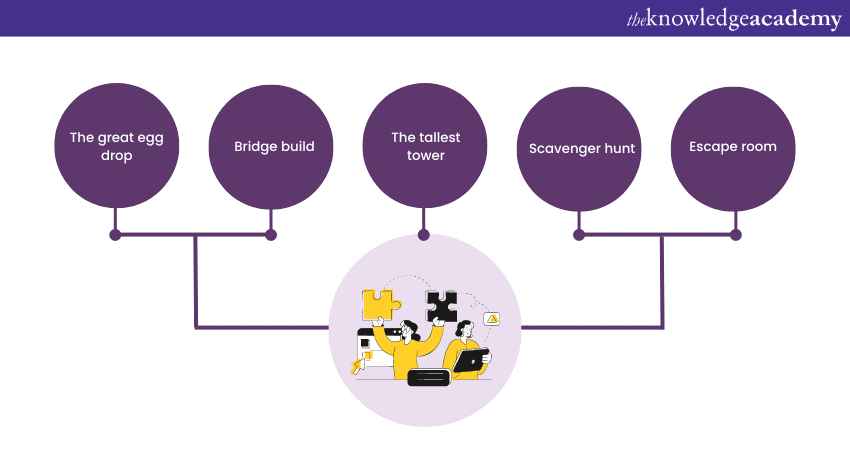
1) The great egg drop: Teams are given various materials and are tasked to create an obstacle to prevent an egg from breaking down when dropped from a considerable height. This exercise encourages creative problem-solving and fosters a sense of shared achievement.
2) Bridge build: Teams are given identical sets of materials and must construct a bridge supporting a specific weight. This task emphasises the importance of planning, collaboration, and efficient resource utilisation.
3) The tallest tower: Teams compete to build the tallest freestanding tower with a limited set of resources. This activity encourages creative thinking and tests the team's problem-solving and collaboration abilities under pressure.
4) Scavenger hunt: A scavenger hunt can be organised either virtually or physically. Teams must work together to find items or complete tasks listed in the scavenger hunt. This is one of the most interesting Team Building Exercises as it improves problem-solving skills and encourages team collaboration. It can also be a fun way to learn more about each other or the company.
5) Escape room: Whether conducted in person or virtually, escape rooms are fantastic problem-solving exercises. Teams must work together to solve puzzles and escape from a locked room within a time frame, fostering quick thinking, cooperation, and a sense of shared victory.
Boost your problem-solving skills and lead your team to success with our Problem Solving Training .
d) Trust building exercises
Trust-building exercises are essential in fostering a sense of mutual respect, reliability, and security among team members. These Team Building activities are created to enhance the understanding of each other's strengths and weaknesses, establish transparency, and create a safe environment for open communication and collaboration. Here are some examples:
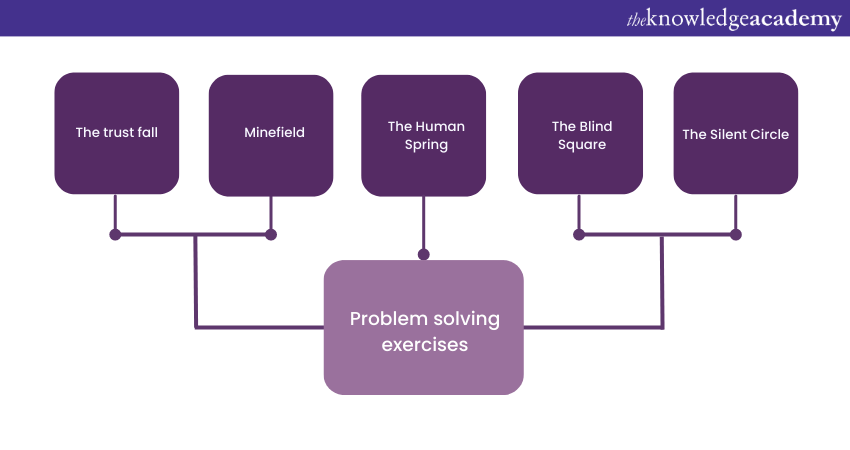
1) The trust fall: A classic exercise, the trust fall requires team members to fall backwards, relying on their teammates to catch them. This physically demonstrates the importance of trust within the team.
2) Minefield: In this activity, certain areas of a room or open space are designated as 'mines.' Blindfolded team members are guided by their teammates through the minefield using only verbal instructions. This helps build trust and effective communication.
3) The human spring: Two team members stand facing each other, reach out, and press their palms together. They then lean towards each other and push back to the original position. This exercise helps build trust as teammates rely on each other for balance.
4) The blind square: In this activity, team members are blindfolded and instructed to form a perfect square with a rope. The task requires trust in each other's directions and highlights the importance of working together for a common goal.
5) The silent circle: A team member stands in the middle of a circle blindfolded while the others quietly move around. The person in the middle has to point to where they believe a team member is, who then confirms. This activity promotes trust in intuition and team members.
Maximise your team's efficiency with our Productivity And Time Management Course.
Fun and engaging exercises
Fun and engaging exercises are crucial in breaking the monotony of daily work, fostering positive relationships, and boosting team morale. They incorporate elements of enjoyment and play, which not only motivate team members but also promote creativity, reduce stress, and enhance overall team bonding. Here are some examples:
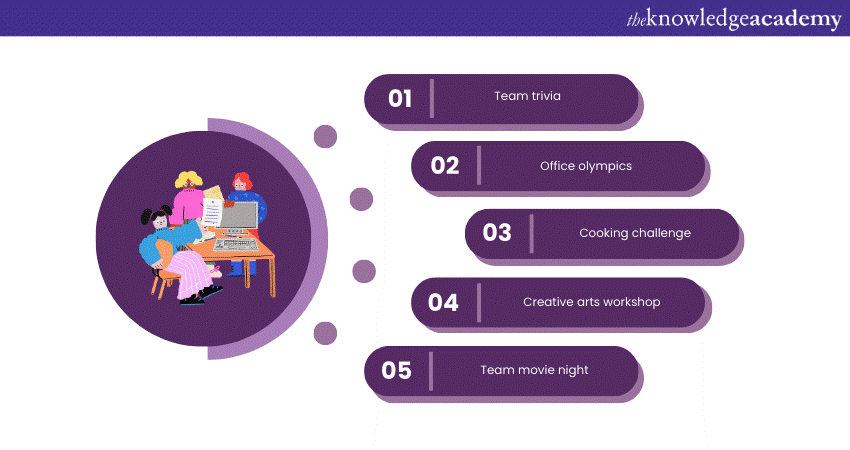
1) Team trivia: A friendly round of trivia can be an engaging way for team members to unwind. This can be work-related to test and enhance knowledge or entirely unrelated topics for fun and relaxation.
2) Office olympics: This could involve various fun games like chair races, paper aeroplane making, or desk ping pong. Not only do these activities lighten the mood, but they also foster healthy competition and teamwork.
3) Cooking challenge: Similar to popular TV shows, teams can have a cook-off with mystery ingredients. This exercise can bring out hidden talents and provides a unique platform for team members to collaborate and create something enjoyable together.
4) Creative arts workshop: Activities like painting, pottery, or jewellery making can provide a creative outlet for team members. This helps in encouraging them to explore new skills and share a different side of themselves with their colleagues.
5) Team movie night: A simple yet effective way to bring teams closer, a movie night can be organised at the office or virtually. This shared experience provides a relaxed environment for team members to bond and engage in casual discussions.
Drive your organisation's social impact with our Corporate Social Responsibility CSR Training!
Conclusion
Team Building Exercises are an indispensable part of creating a thriving, collaborative, and efficient work environment. They serve to foster better communication, enhance problem-solving abilities, build trust, and, most importantly, make the workplace more enjoyable. A team that can work together will succeed together.
Elevate your management skills and unlock your team's potential with our Management Training
Frequently Asked Questions
Upcoming Business Skills Resources Batches & Dates
Date
 Management Training for New Managers
Management Training for New Managers
Fri 31st May 2024
Fri 26th Jul 2024
Fri 27th Sep 2024
Fri 29th Nov 2024







 Top Rated Course
Top Rated Course


 If you wish to make any changes to your course, please
If you wish to make any changes to your course, please


